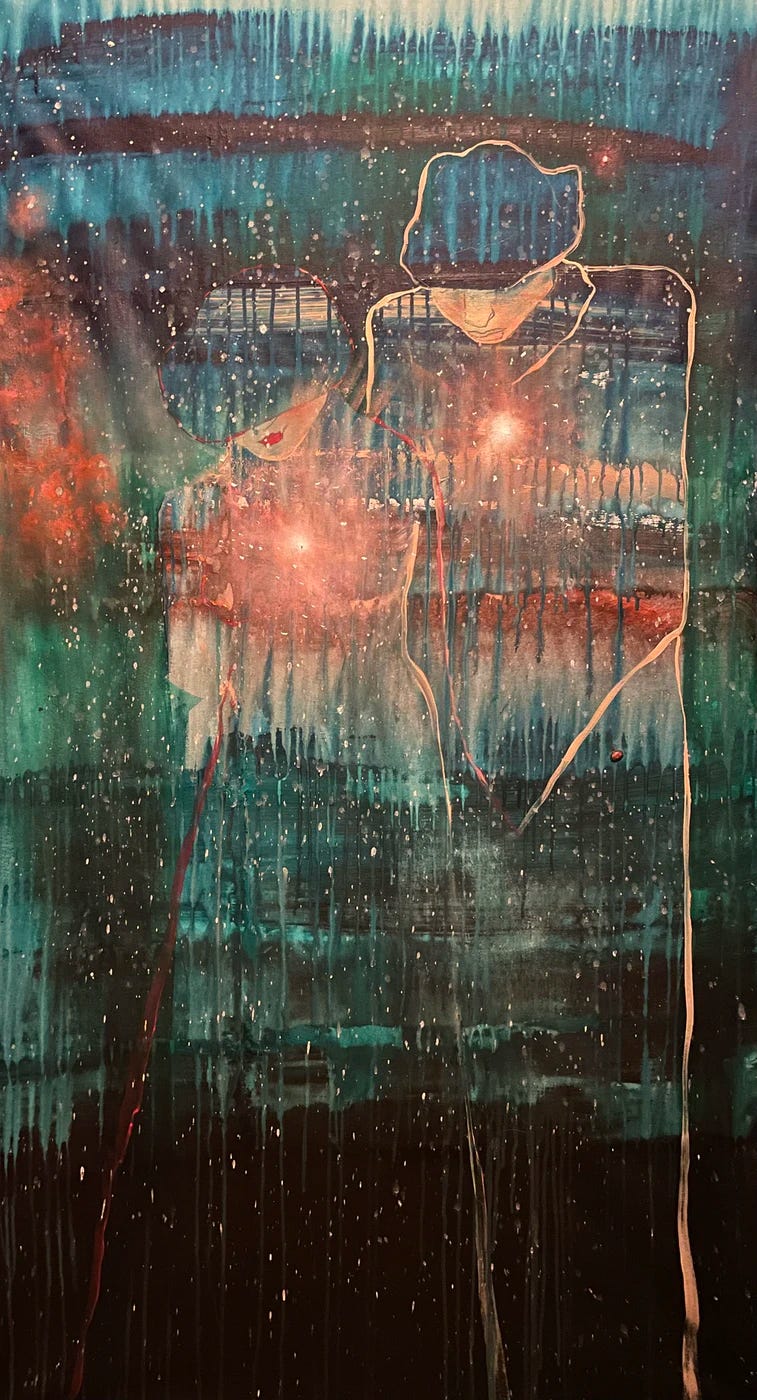Image, Memory, and Dementia
I rewrite the past in correspondence with who I am becoming
Another installment in the series of dialogues with Benjamin Life. I’m finding quicker access to interesting material when I am actually engaging a person instead of a computer. I hope any computers out there aren’t offended.
Benjamin Life
We’re inviting the audience to tune in and share their feedback on what they want to hear Charles jam on in our next conversation.
- A deeper exploration of beauty as an orienting principle for civilization.
- The long term effects of the toxic seeds of our current society
- What it means to be lost in abstraction, what it means to be hermetically sealed world of digital reflections
- Resuscitating and reclaiming leadership
- Transforming anger into awakening understanding
- The evolution of masculinity and collective healing
- What is true health?
- Myth and placemaking
- The nature of evil
- The relationship between essence and reproduction (ala Derrida, Foucault, Walter Benjamin)
Charles Eisenstein
We’re in the midst of a house move right now. I don’t have a lot of accumulations, somehow, but I was looking through a box that was leftover from my last house move. It had some photographs from when my eldest son Philip was a little baby. And Stella and I were looking through some of these pictures, and she said, “These are so precious. These are treasures.”
I do like taking them out and looking at them every five years or so. But it struck me that when I do look at them, I often just feel a lot of sadness. It brings up all of the things that I missed out on in life and was too preoccupied to really enjoy, like my kids’ childhood. I have a lot of grief and regret around it, and I could easily see how photographs and memories that are anchored by other physical objects could become a quagmire where I get stuck in the past because I have not fully processed some of these emotions, but just moved on in the rush and press of life.
Maybe this is one of the causes of dementia. It happens with a certain number of old people that they get lost in the past. But, they may be just the most noticable example of something that happens to almost everybody.
The past has been made real in a tangible way for me to look at, real in a way that our brains’ never had before the advent of photography. There you are looking at your child as he looked 25 years ago, looking at your partner as she looked 10 years ago, and that’s the evidence to your eyes right there, that this person looks like this or this person is a child. You know, conceptually, the child has grown up, but here your eyes are also telling you something very different. On some pre-rational level, it’s really confusing. The same confusion also comes when people surround themselves with precious objects. It’s not just precious photos, but precious heirlooms: here’s the baby blanket that Jimmy used when he was little. Here are all these things that make it hard to move on and that contribute to the illusion that the past is still here, and that maybe you can actually hold on to it.
In a way it is true — you can hold on to the past in a way that you couldn’t before, with the ability to reproduce images. All the more if you go back to nomadic times, when you really couldn’t hold on to anything. Life then was much more in the reality of a constant present.
So we now have a media environment that is full of frozen images — or even more potent, videos, with sound and image and motion all together. Every time you look at that, deep circuits in your brain say, “This is real, this is happening.” But it isn’t happening. So we get stuck in this feedback loop where the present is fed by the past, but the past looks like it is still present. It’s a kind of a psychic trap.
Now, I’m not standing up on a soapbox decrying this development. But I think it does help us to be aware of the insidious spell that images exert over us. They facilitate a much higher degree of delusion than would be possible if we only had stories and memories to rely on. Because those change. My memories of my children when they were little guys, the memories change as I change, and, to some extent, I rewrite the past in correspondence with who I am becoming. Aspects of the past that had been invisible at the time that I hadn’t noticed come into my awareness. Maybe these photographs can actually help that. They can break through the illusions I have about the past.
The power of the photograph, of the image politically, has been to pierce illusions. I’m thinking of the photographs of the war crimes in Vietnam, or the events of Tiananmen Square, that said to us, here’s what’s really happening. But today with the ability to fake these images, and even to fake videos, that function of piercing illusion is lost. And images have become even more fake, even more than just through the ability to select them and to frame them. They already were no longer a reliable lifeline to reality, outside of our stories and perceptions, but even more now, with the ability to fake them, and to alter them through seamless technologies of manipulation. Instead of anchoring us to objective reality outside of our delusions, they deepen the delusions even more. And we risk as a society getting completely lost in manufactured realities that are not actually reality. They are an illusion. But the more lost we get in them, the more real they seem, except for some quiet and increasingly desperate voices that summon us back to the body, to the earth, to life instead of its simulations. And I guess, to just circle back to the topic of dementia, one way to look at it is living in the internal simulation of reality that has drifted further and further away from what’s really real.
Benjamin Life
This is really touching home for me in a lot of dimensions. My father has Parkinson’s disease and has started to have increased hallucinations. And it’s been very challenging to watch that internal projection of reality gradually take over more and more of his experience and watch the effect that that has on other people. Then another dimension is I studied to become a photojournalist when I was in college, and I studied under a relatively famous war photographer. He brought us to Burma on a photojournalism immersion trip. And it was actually quite disturbing to me to see behind the lens of how these dominant narratives are constructed. Because this was a person who had zero context of relationship with a place, very much this colonial insertion of a lens, of a viewpoint. And to see how those images were constructed: Basically, someone comes in with a perspective, they find a local fixer that they can pay a relatively high salary based on local wages. And that fixer helps them gain access to the thing that they’re trying to document based on their pre-existing biases and frames. They see it through the lens that they’ve brought into that particular place. And then it’s those images that get put through the mass media reproduction machine. And that is what creates the global narrative of what’s happening there. But it’s whole cloth, from beginning to end, completely disconnected and only represents a biased, low-context interpretation. And the way that it’s framed actually creates the dominant narrative because the photo is seen as real even though it’s the subjective product of a photojournalist. And so I realized that I couldn’t in good faith be a photojournalist, because I knew that my lens would never be sufficient to actually provide the context required to help people understand other human beings’ lived experiences.

Charless Eisenstein
Yeah. In fact, the perception that a photographic image is objective is part of the insidious spell that it casts. Because your eyes are saying, Oh, I’m seeing this. But it’s actually not some random glimpse into another place that you’re seeing. It’s a very highly curated and managed Potemkin village version, deliberately cast in some version of what is actually there. And this has been recognized now for a century as the power of the photographs, the power of the photograph as propaganda.
I want to return to Parkinson’s disease, and your father’s episodes of delusion. I’m not sure if that’s actually a bad thing. Thinking of my own unprocessed grief that is brought up when I look at these old photographs, maybe the last phase of life is actually a time when when the imperative of the soul to process and integrate everything becomes so overwhelming that you withdraw from your current environment and revisit and process again and again and again all of these episodes from the past and feel all of the things that you didn’t get a chance to feel back then because you were distracted or addicted or preoccupied. And now that your creative functions in the world are diminishing, it’s time to look at all of those things again.
So we might not even want to call it dementia. It could be another function of the brain coming to the fore, another function of the mind whose time has come. But I don’t know. I don’t like being the word police, so we’ll call it dementia. Maybe now you get to experience not just the grief, but the joy. These people living in the past are reliving memories that are 50, 70 years old. They might not even recognize the people around them right now or they might mistake them for people that they knew a long time ago. They might think that their spouse is still alive. They might think their parents are still alive. They might talk about friends who have been dead for 20 years. All of this, that we see as a pathology, could be really the healthy functioning of the soul as a kind of a preparation for the afterlife in which, according to many accounts, we spend a lot of time reviewing the lives that we have lived, consulting with spirit guides or our soul group about the choices that we made, the extent to which we accomplished the purpose of our incarnation, what we learned and what we didn’t learn and might need to practice again. This whole process of review and integration can start before death, as one retreats from incarnation. This retreat certainly happens in old age, but it can also happen episodically throughout life. And that may be why people who meditate have a lower rate of dementia. Because, they’re accomplishing some of this review process in meditation.
Benjamin Life
In the case of my father, the hallucinations seem to be deeply subconscious, symbolic representations of different things that have haunted him throughout his life. And so they’re not really the past so much as deep archetypal unconscious symbols that he is experiencing as physicalized hallucinations.
Charles Eisenstein
And then that could also be a way to process some of the things that maybe he was too busy to really go into. I don’t necessarily want to psychoanalyze your father, but the point is that what we see normally as illness or pathology might actually be an expression of health. The soul has its own agenda. Maybe we don’t hold someone like your father in the story of a sick person who needs to be medicated or needs to be fixed.
![]()



